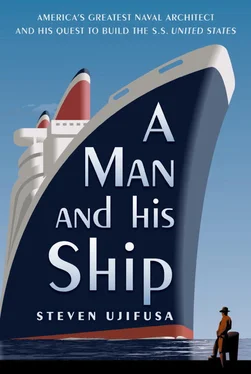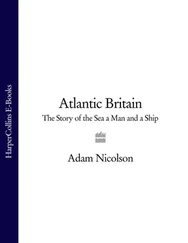Admiral Taylor, a man of full face and warm eyes, soon became William Francis Gibbs’s informal mentor and surrogate father, providing him the support and guidance that his own father never did. For his part, the aspiring naval designer admired the man who he said “had the rare advantage of a brilliant mind and a natural talent for expressing himself in concise scientific language. He was never satisfied until he had reached perfection in exposition and he avoided always the pitfall of stating opinions that were not completely buttressed by the facts.” 19
After his meetings with Emmet and Taylor, Gibbs finally felt free to resign from his law firm to work on the superliner project full-time with Frederic. He had fulfilled his agreement with his father for a year of unhappily practicing law. Packing his belongings, he left New York and joined Frederic in Philadelphia.
A month later William Francis walked into the huge Navy Experimental Model Basin in Washington Naval Yard. Floating serenely in the basin was a 41.7-foot-long pine model of the Gibbs design called “Proposed American Passenger Steamship.” It would carry the Navy project number S-171. 20
The model showed some changes made by Admiral Taylor to Gibbs’s drawings—the ship looked lower, sleeker, more modern. The superstructure now had three decks high rather than four. A knob-like cruiser stern replaced the overhanging counter-stern, and the bow projected forward slightly. But the basic hull design remained what Gibbs drew—rather than the round, full lines of other large passenger liners, the ship’s bottom was sharply cut out at both the bow and stern, reducing the ship’s underwater volume. Taylor did not add a bulbous bow, probably because he did not feel quite ready to use it on such a large craft.
The tests began. The model was towed the length of the tank in a variety of simulated conditions: flat calm, moderate seas, and gale conditions. Despite its fine lines, there was none of the nauseating corkscrewing that afflicted lean-hulled record breakers such as Mauretania. Nor did the model roll drunkenly like top-heavy German ships. And most important, when towed at a simulated maximum output of 180,000 horsepower, the model moved effortlessly through the water at the equivalent of 33 knots, an astonishing six knots faster than Mauretania ’s top sustained speed. 21
But model tests were just one step on a long road. The U.S. Navy was not in the business of building commercial ships. The brothers needed financing from a private source. With Emmet’s and Taylor’s design modifications in hand, and Frederic’s financing plan for a railroad tie-in, the Gibbs brothers decided to go see Ralph Peters, the president of the Long Island Rail Road, a subsidiary of the Pennsylvania Railroad. Because the brothers thought a letter from two unknowns would end up in the trash, they decided to show up at Peters’s office in person, and make him listen to them.
“Mr. Peters is very busy today,” his secretary told the two strangers, not looking up from her typewriter.
“Tell him some men want to talk about ships from Montauk to England,” Gibbs insisted.
The secretary told the Gibbs brothers to wait outside.
For the last ten years, various idea men had hectored Peters about building a new terminal in Montauk. For most of that time, Peters was preoccupied with the completion of the Pennsylvania Station and rail tunnels under the East River. But by 1916, with trains moving in the tunnels, Peters needed a new project. He knew all along that all of the freight and passenger traffic coming into New York could be monopolized if the piers could be directly tied into the Pennsylvania Railroad and the LIRR.
After his secretary told him about his uninvited visitors, Peters strode out of his office, his rosy face showing a big smile.
As Peters thumbed through a black leather-bound volume containing the proposal, he said he loved the idea of a Montauk terminal. But when he saw the superliner design, his eyes bulged. It was huge. Not only that, but its proposed turbo-electric power plant had the stamp of approval from William Emmet and its hull by none other than Admiral David W. Taylor.
The railroad man stared intently at the two young men and asked what engineering qualifications they had.
They said none.
Peters picked up the phone and called the office of J.P. Morgan and Company, saying he wanted to speak to Jack Morgan. 22
Approaching sixty in 1916, “Jack”—or J. P. Morgan Jr.—had led a charmed life. Following his graduation from Harvard in 1889, he floated effortlessly to the top of the House of Morgan. Despite not being especially close to his father, he had inherited $69 million when the older Morgan died in 1913. He also received the legacy of three generations of New England and New York banking prominence, and close ties with international heads of state and business.
When Peters’s call came, Jack Morgan was in no mood to meet with anybody. He had just survived an assassination attempt. On July 3, 1915, a former Cornell University professor named Frank Holt drove through the gates of J. P. Morgan Jr.’s estate at Glen Cove, Long Island. Wielding two revolvers, Holt assaulted Jack Morgan and the British ambassador Sir Cecil Spring-Rice. A bullet struck Jack in the hip, and another tore through his thigh. The butler ran up from behind Holt and smashed a lump of coal against the side of his head, after which the police arrived and arrested the would-be assassin.
Newspapers readers learned that Holt had set off a bomb at the U.S. Capitol the day before he showed up on Long Island. The former professor, a German sympathizer, was outraged over the House of Morgan acting as Great Britain’s American financial agent. 23Much of the war supplies traveled across the Atlantic on vessels owned by Morgan’s shipping trust: the International Mercantile Marine.
Jack Morgan made a complete recovery. “The experience was a very disagreeable one,” Jack wrote to his friend Owen Wister. “I was singularly fortunate.” 24
Jack Morgan’s place of business was at 23 Wall Street. The House of Morgan lay hidden in a forest of skycrapers at the southern tip of Manhattan, an austere gray limestone building only five stories high. It looked more like a temple than a bank. Yet its power inspired near-religious awe on Wall Street, for it underwrote securities for the biggest trusts in the world, including the International Mercantile Marine.
It was here that William Francis and Frederic Gibbs had their audience with a recovered Jack Morgan and Philip Franklin of IMM.
“My brother and I proceeded immediately to lay out our key designs and blueprints,” Frederic recalled later. “As we did, my brother explained each special feature.”
The drawings called for the two largest and fastest ships ever constructed. Each would cost about $30 million, more than three times the amount J. P. Morgan Sr. had paid to build Titanic several years earlier.
The young designer then launched into the second part of his presentation: the Montauk sea-land terminal would cost about $15 million, and would have easy access to ground transportation, as well as plenty of room to expand.
Suddenly Jack Morgan got up from his seat and walked out of his office. Franklin scurried after his boss, and a door slammed behind them.
The Gibbs brothers sat in Morgan’s office, as their confusion turned into anxiety. “That wait seemed like eternity,” Frederic recalled. “It was about 20 minutes, but each minute seemed like an hour. We stood and looked at each other. I rolled up some of my biggest blueprints. My brother looked at his watch. Neither of us said a word. For the rest of my life I never have endured a wait such as that one.” 25
Читать дальше












